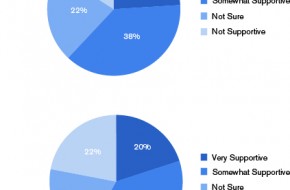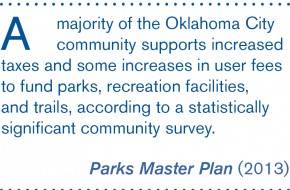Our Situation
Funding, Maintenance, and Operations
Funding. Recent approval of bonds for new park investments, including the MAPS 3 Park in the Core to Shore redevelopment area, trail projects, and general obligation bonds for park improvements, has demonstrated public support for park and recreation funding. Yet, Oklahoma City’s park system has historically been underfunded compared to peer cities. In 2012, the Parks Department’s per capita budget of about $40 compares to $65-70 for a group of comparable Midwestern cities. Despite substantial bond funding for park improvements, the City does not have a permanent, dedicated fund for capital improvements, often necessary to replace smaller items. By comparison, “best practice cities” cited by the Parks Master Plan spend 3 to 4% of their total asset value on facilities and infrastructure. Oklahoma City also ranks low on informal recreational activities ($8.42 per capita compared to an average of $20 per capita).
Maintenance. The cost of maintaining existing parks is increasing, especially as facilities age, but Oklahoma City’s level of maintenance expenditures are considered very low in comparison to peer cities. Depending on the classification of parks, typical maintenance expenditures are between 40 and 60% of its peers. The Parks Master Plan found that most of the city’s park system is maintained at a “Mode III” level according to the National Recreation and Parks Association (NRPA) maintenance standards, again well below the typical level in comparable Midwestern communities.
Revenue Sources. A complicating factor for Oklahoma City is the fact that property tax dollars can only be used for capital projects. Maintenance and operations must be funded by other sources, typically sales tax revenues. Economic downturns, changing buying patterns (including on-line sales), and regional competition for market share all affect the availability of funds for maintenance and operations.
Interestingly, the Parks Master Plan’s community survey indicated that citizens are willing to pay more for park investments and services. About 62% support at least some tax increase and 58% supported some increase in user fees to pay for parks, trails, and recreation facilities.
Programming and Facility Needs
Evolving preferences and economic conditions appear to have both changed and increased demands on local park facilities. A growing interest in stay-at-home vacations has increased demand for nearby facilities that do not require out of town travel. Public interest has also grown for such specialized facilities as dog parks, skate parks, and rowing courses. The growing popularity of sports like soccer has also created demands on parks that were designed around other, more “traditional” activities.
Demographics. Demographics have also had an impact. For example, older adults, growing as a percentage of total population, have new recreational needs, although the conventional concept of “senior centers” and age-segregated facilities is becoming less likely to appeal to aging baby-boomers. Increases in ethnic populations also increase demands for specific sports, as evidenced again by the high utilization of soccer fields.
Replacement. In Oklahoma City and other cities, many major facilities, notably swimming pools and recreation centers, were built at the same time and are reaching the point of needing major repair or reinvestment. The outdoor public swimming pools of the 1960s and 1970s do not respond well to the needs of either serious swimmers or more informal users, and are expensive to replace or rebuild. In many situations, water playgrounds or splash parks have served local needs with lower capital and long-term maintenance costs.
Community Needs. The community survey, completed as part of the Parks Master Plan process, provides particularly useful information on trends in recreational needs and preferences among Oklahoma City residents. Despite the attention typically given to organized sports and major activities, the highest facility priorities tended to focus on less formal, individual activities and linkages. Across all parts of the city, the highest facility priority was walking and biking trails (38% of the sample); the highest program priority was adult fitness and wellness programs (22%); and the highest action priority was upgrading neighborhood parks (28%).
Levels of Service
The Park Master Plan analyzed levels of park service for four Level of Service Tiers:
- Central City, including the area enclosed by the historic Grand Boulevard loop.
- Urban Area, including developed areas outside the central city.
- Urban Growth Area, including areas designated for growth, and generally corresponding to the area that either has or can be feasibly served by urban infrastructure like city water and sewer.
- Rural Area, including the balance of the corporate limits.
Using current population trends, the analysis found that most existing parks are located in areas that are expected to be either stable or lose population to 2030, and that areas expected to gain substantial population are relatively lacking in park service. It further established service standards for local parks, regional parks, and trails for each of the tiers and concluded that:
- Within the Central City Tier, most areas were well served by all three levels of facilities (local parks, regional parks, and trails).
- Within the Urban Area, most areas were well served by local parks, but only some areas met service standards for regional parks and trails.
- Within the Urban Growth Area, few areas were well served by local and regional parks, and even fewer were well served by trails.
- Within the Rural Area, very few areas were well served by any type of facility.
It is important to note that the Parks Master Plan based its analysis on current development trends. The preferred “Efficiency” growth scenario (see Chapter 1) (favoring infill, higher density and mixed use development, and less expansion at the city edge) is likely to reduce the need for new open spaces at the outer edge of the Urban Growth Area and require new parks in that sector contiguous to existing development. It will also increase utilization of parks and suggest a need for a trail network in the Central City and Urban Areas. The master plan analysis also did not consider issues of maintenance or serviceability of specific parks. The Efficiency Scenario suggests a greater need for rehabilitation and enhancement of parks within the existing urbanized areas
Accessibility and Use
Health and wellness issues among our population as a whole and young people in particular have sparked greater and broader interest in active transportation. While active transportation planners often focus on commuting, many studies show that citizens consider parks and recreation facilities to be the highest priority destinations for bicycle and pedestrian travel. Safe pedestrian and bicycle connections make people less dependent on cars (and parents) for access to recreational facilities and, in effect, extend service areas for individual facilities.
The Oklahoma City Parks Master Plan found that a significant majority of people were willing to walk or bike for at least a 20-minute distance, or a mile on foot, to a park. However, a majority did not consider themselves within walking distance of a park. For comparison, about 54% of the sample would be willing to drive 20 minutes or more to a park – about the same travel time as walking a mile or cycling three to four miles.
Safety and Design
People will avoid parks that they consider unsafe; and lack of use in turn makes parks less safe and reinforces the cycle of perception creating reality. Appropriate design, landscaping, lighting, views, and emergency features in parks and along trails all contribute to a feeling of comfort that generates the greatest possible safety measure: desirable human activity. The concept of Crime Prevention Through Environmental Design (CPTED), promoted by such organizations as the U.S. Department of Justice and the National Crime Prevention Association, established principles to guide design in public places. The Oklahoma City Parks and Recreation Department currently follows these principles.
Social and Environmental Effects
In the past, parks and recreation have been considered to be a community quality issue, important to the city but always somehow secondary to “essential” infrastructure like streets and sewers. Thus, when budgets get tight, park development and maintenance can be one of the first things to be cut or deferred. But national concerns about the economic and human impacts of increased incidence of obesity and its resulting effects on health have changed many of these perceptions. The causes of the dramatic increases in rates of overweight and obesity are undoubtedly complex and are almost certainly not the result of any single factor. But it is clear that a decline in routine physical activity correlates strongly to increasing rates of obesity. This national epidemic is of particular significance to our children. Concerted efforts to publicize the benefits of both healthy diet and increased activity have begun to bear fruit. According to a study by the Centers for Disease Control in early 2014, childhood obesity rates seem to be leveling off. That is good news, but much more work needs to be done.
As we have seen, this trend has proven to be particularly vexing for Oklahoma City. According to the American Fitness Index (AFI) in 2013, we rank 48th in personal health, 42nd in community health factors, and last overall among America’s fifty largest cities. Almost 30% of our population has reported no significant physical activity during the 30-day period before the survey. The AFI placed the city’s obesity rate at 30.1%. Active living facilities, including parks and recreation, are a significant part of the solution to this condition that imperils our overall goal of community health and sustainability.
Nationwide, household health is also strongly related to income and ethnicity factors, which are in turn highly related to each other. Lower-income households are especially reliant on the condition and usability of parks. The Parks Master Plan shows that these relationships also hold true in Oklahoma City. The city’s African-American and Hispanic populations tend to live in the northeast and south-central parts of the city. These areas also exhibit the lowest median incomes and lowest health score concentrations.
























 Download PDF
Download PDF
